December 2nd Transform Westside Summit: Delivering on BeltLine Promises
Westside Future Fund’s December 2nd Transform Westside Summit featured Atlanta BeltLine, Inc. and Atlanta BeltLine Partnership. Spanning 22 miles of picturesque walking/riding trails, the BeltLine continues to attract businesses and homebuyers alike, helping to increase both the values of nearby properties and, consequently, fears of many legacy residents and business owners being displaced. The summit focused on how the BeltLine is delivering on promises to help bring equitable and inclusive revitalization to Atlanta on an unprecedented scale. Special guests included: Clyde Higgs, President & CEO, Atlanta BeltLine, Inc.; Rob Brawner, Executive Director, Atlanta BeltLine Partnership; Freddie Stevens, Director of Housing, Grove Park Foundation; and Cassandra Ingram, Owner, Urban Grind. John Ahmann, WFF’s President & CEO, moderated the panel after attendees were welcomed by cohosts Ebony Ford and Benjamin Earley.
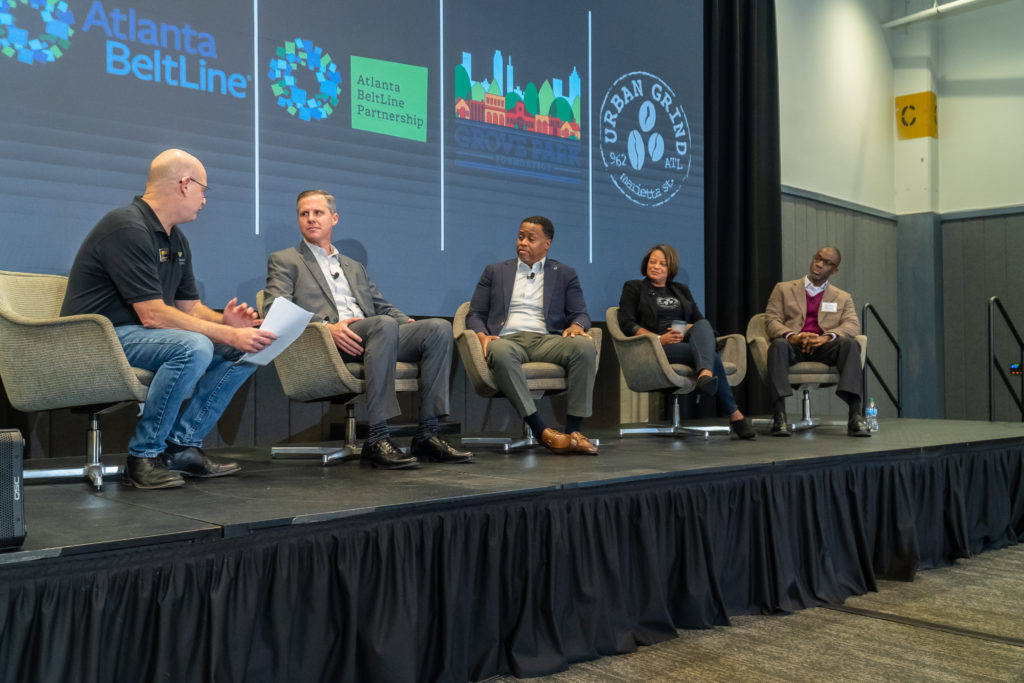
(From left) John Ahmann, WFF; Rob Brawner, Atlanta BeltLine Partnership; Clyde Higgs, Atlanta BeltLine, Inc.; Cassandra Ingram, Urban Grind; and Freddie Stevens, Grove Park Foundation.
Brawner: “The Atlanta BeltLine Partnership, and our role as the 501 C 3, supporting the project and working closely with our partners at Atlanta BeltLine, Inc. and many other nonprofits is threefold: we enable the project, we engage residents, and we empower those living in neighborhoods around the BeltLine. Our empower work is really helping to connect residents living in communities around the BeltLine with resources [so] they can stay in their homes, they can connect with jobs, and they can ultimately benefit from the quality of life that the Beltline provides.”
Higgs: “Atlanta BeltLine, Inc. is the city’s official implementation agent for the Beltline. And so, we are a team of about 60, women and men, architects, designers, engineers, urban planners, development professionals on the real estate side, and we advanced the project. We essentially build it. So I’ve been CEO for Atlanta BeltLine, Inc. for roughly about four years. Originally joined the organization as the Chief Operating Officer, and I will tell you this is in honor of a lifetime to lead such an impactful project.”
Ingram: “Our flagship store, I can say now is located in West Midtown, and I’ve been there for 16 years and finally scaling and doing some fun things. Were a part of the Beltline Marketplace Pilot program at 1089 Allene Avenue.”
Stevens: “The Grove Park Foundation is a place-based nonprofit and part of the purpose built communities. That work is based obviously in Grove Park, but we serve the entire northwest corridor. Like Westside Future Fund, we are committed to affordable housing, the anti-displacement efforts on the Westside. We’re supporting economic development initiatives, specifically, serving the legacy families that live and work and worship on the northwest corridor of Atlanta.”
Ahmann: “What can we expect on the Westside from the Atlanta BeltLine over the next few years?”
Higgs: “One of the most important things that happened for the BeltLine and the city of Atlanta was the passage of a Special Service District called the SSD. The SSD, when whoever writes the next book about the city of Atlanta or about the BeltLine, this was such a pivotal moment in our history, the passage of this new district. What this is… is essentially a CID (Community Improvement District) around the BeltLine, and this is going to raise about $100 million through this taxing district called the SSD.”
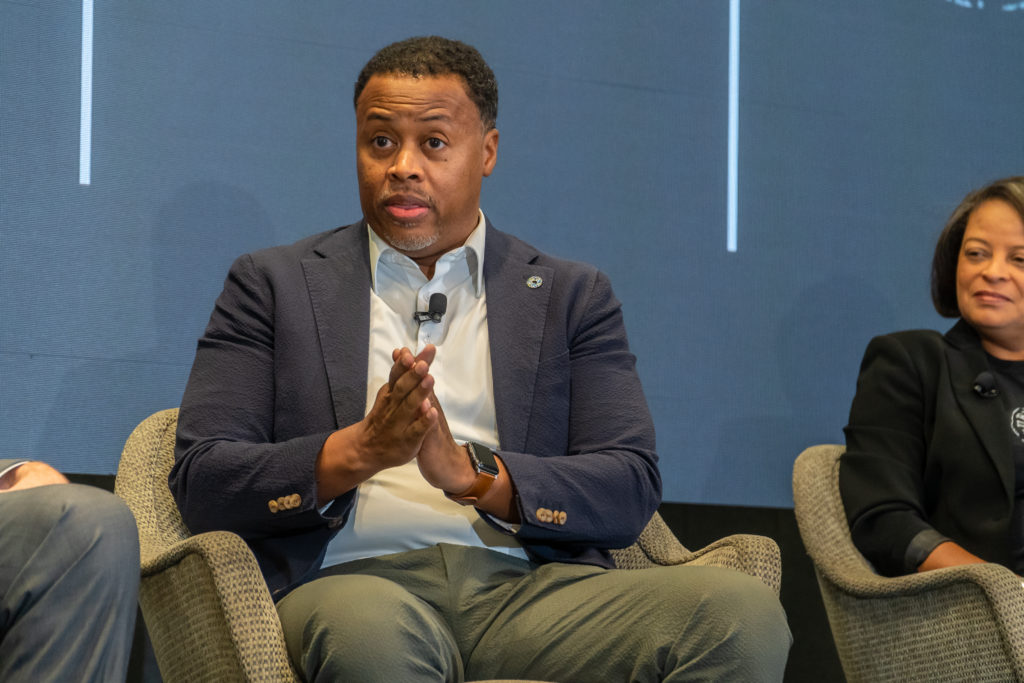
Clyde Higgs, President & CEO of Atlanta BeltLine, Inc.
Higgs: “We now have clarity that we will finish the Beltline by 2030. […] There were a lot of doubters with a lot of haters about, you know Atlanta would never be able to accomplish such an ambitious project. We are there… within the next 24 months, 80% of the Beltline will be finished or under construction—game changer. We did not have clarity about even finishing the BeltLine pre SSD. The passage of that really needs to go down as a critical moment not just for the BeltLine, but really for the city of Atlanta.”
Ahmann: “When the tax allocation was initially passed out, a portion of the funding was to be dedicated to affordable housing. I can tell you, at the time when people would get it, no one had any idea of how fast things would move. The amount of TAD (Tax Allocation District) Funding that was set aside, would be woefully inadequate and unforeseen but I think one of the learnings was controlling land, if you want to have affordable housing, which we’ll talk about.”
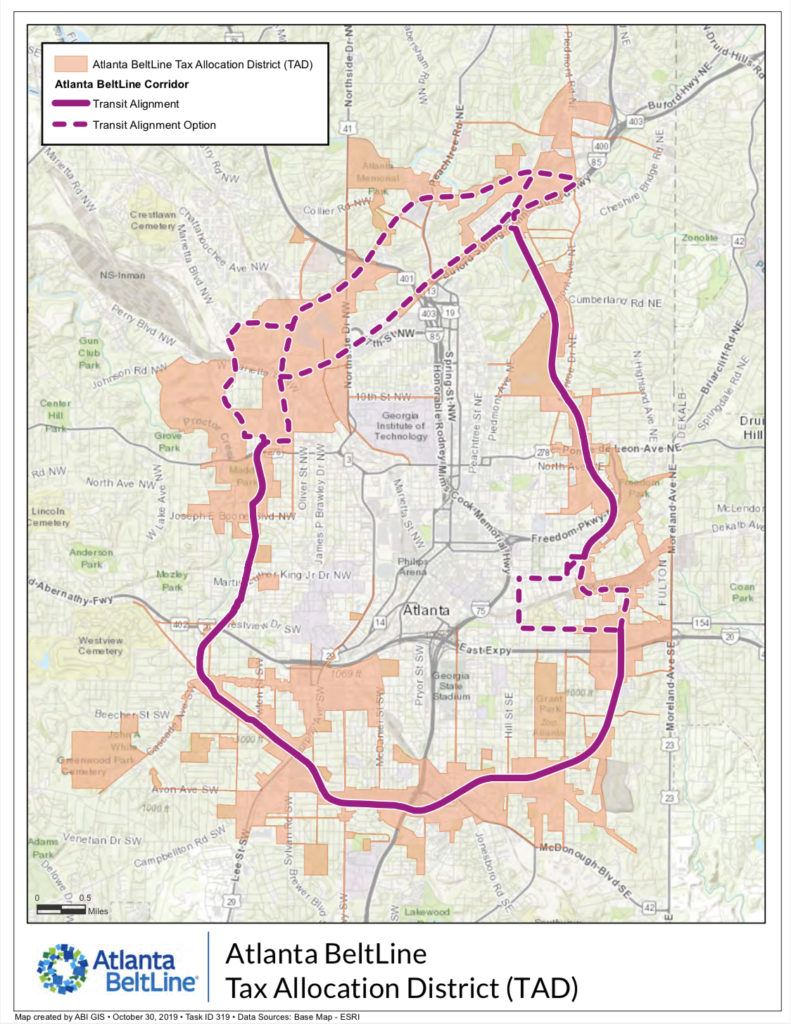
Learn more about the Atlanta BeltLine TAD here.
Higgs: “That’s probably one of the untold heroes of the SSD passage. What it will do, it will essentially free up additional monies that we can spend on housing affordability, which is again game changing for us. So, you hear a lot about the Beltline goals to produce or preserve 5,600 units of affordable housing by 2030. That’s a stated goal for us. But beyond that, it is really critical to make sure that you control the land.”
“When you control the land […] it allows you to do really deeper, long term and perhaps permanent affordability when you actually control the dirt. That was a historic transaction for BeltLine.”
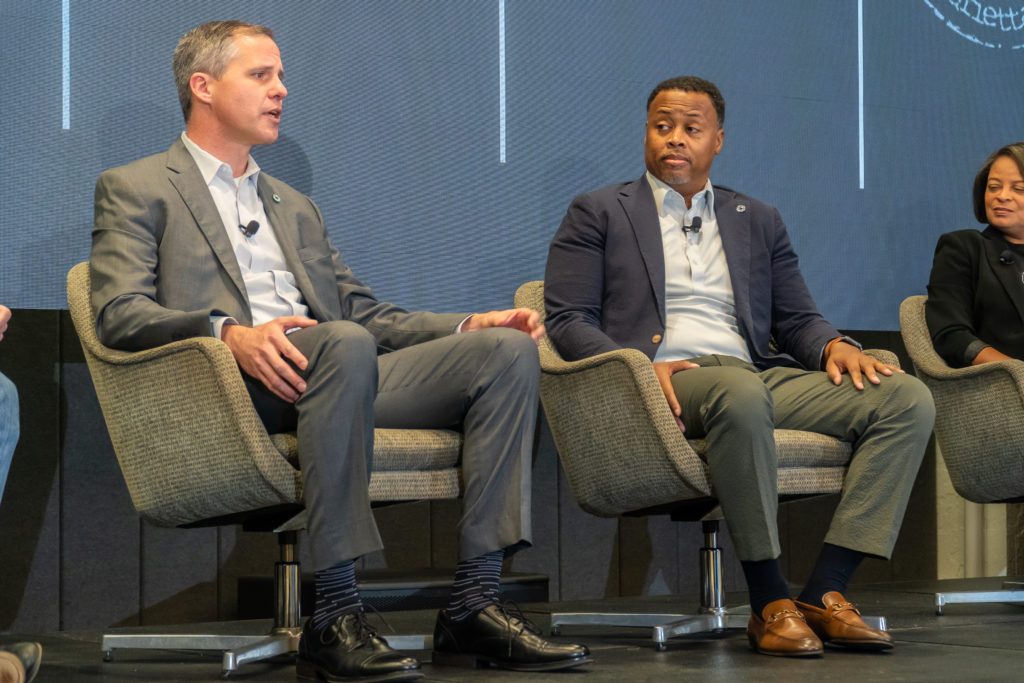
Rob Brawner (left), speaks to the philanthropic community’s involvement in the project.
Brawner: “Let’s just be clear, we wouldn’t have had an SSD if Clyde and the ABI team didn’t put $100 Million in first from the TAD. That allowed us to get the support of the property owners and then of course philanthropic community. And a huge shout out to both the Woodruff Foundation and the Cox Foundation for their incredibly generous, more than $100 million contribution to be part of this capital stack. The federal funding has also come. There’s been significant federal funding and all that’s come together so that full trail corridor can be completed.”
According to Brawner, the BeltLine has raised about $200 Million philanthropically.
Brawner: “There are additional phases of Westside Park that we’re currently raising funds for, and NoDa Park, which is a, a future jewel on the Westside trail. South of I-20 in the Westview neighborhoods. It’s going to be both a gateway into that neighborhood as well as a destination in and of itself right across the street from KIPP Strive. We’re currently raising funds for that.”
…
Ahmann: “Let’s go to Cassandra. Thank you for being here. From your perspective, talk about the wins on the BeltLine you see for businesses on the corner. You might also reflect on what are some of the challenges for businesses trying to take advantage of it.”
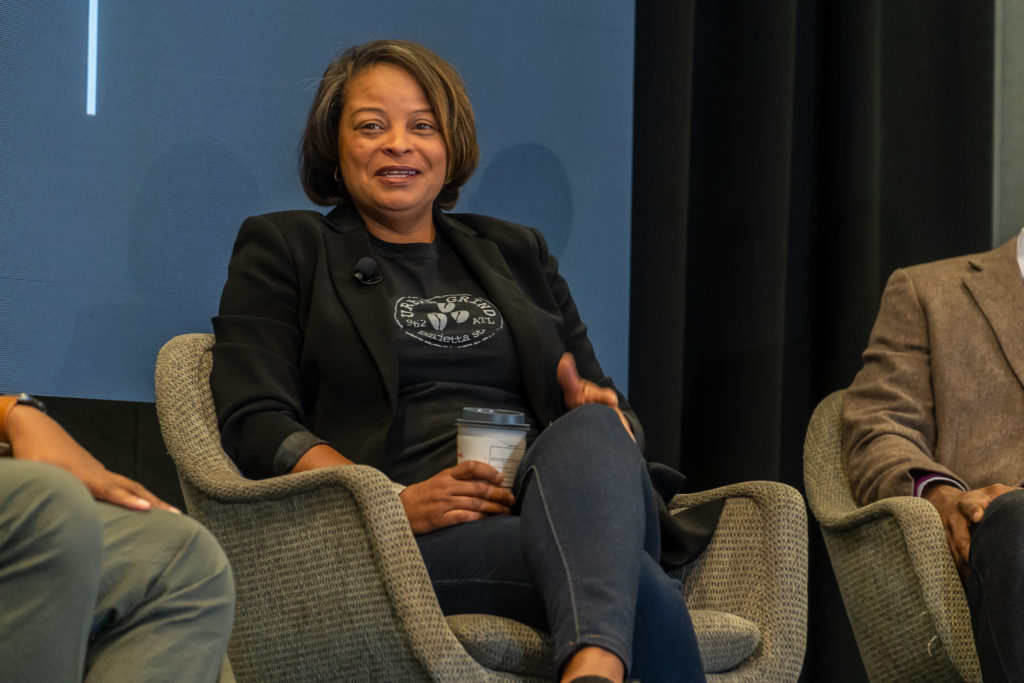
Cassandra Ingram, Owner, Urban Grind.
Ingram: “The BeltLine has stepped up and said small businesses are important and are including us. There’s so much development and growth that has happened in Atlanta and it’s amazing, I love it, being a resident here myself… But the small businesses sometimes are left behind. We’re excluded from those opportunities. What this program really has allowed us to do is be a part of it, have a seat at the table, be a part of this development and be a part of the growth and grow with it.”
“I started Urban Grind 16 years ago on West Midtown, and there was no program that was like this. Myself and other small businesses, when we have limited resources, we have to say, ‘Okay, what’s new and next? Where can we go in and plant our feet and get rooted so we can be a part of the infrastructure when it comes and hope that we have enough money and enough resources to survive until that change happens?’”
“This really gave us an opportunity to be at the table early. A lot of businesses that are younger than me are on the BeltLine where it’s taken me 16 years to get there. And people next door to me, they’ve only been open a year, which is amazing.”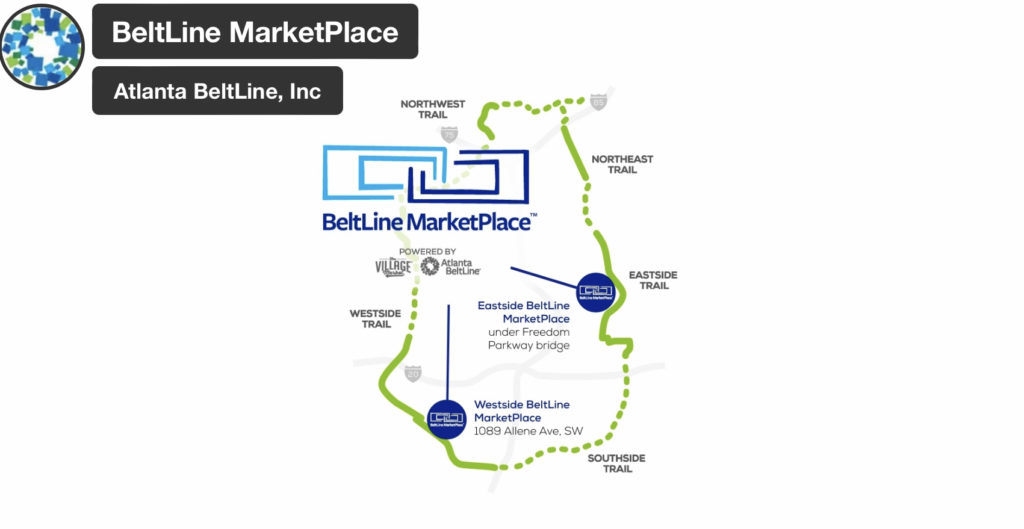
Higgs: “The Beltline Marketplace is there to give opportunities to small businesses, for them to really take advantage of the 2 million plus people that are walking on the BeltLine trail from an annual basis. You will see that if that pilot is successful, a goal is to populate these little pods, essentially they are refurbished containers. We will populate that around the 22 mile loop of the BeltLine.”
Ahmann: “Even with all that opportunity to come in, what are some of the key challenges and concerns residents are facing in Grove Park? Some of the programs that are out there to help address people? Also, what more needs to be done?”
Stevens: “The Westside Park, as great as it is, created that dynamic, negative potential impact for the residents who want to remain in the neighborhood or the businesses that want to remain in neighborhood. Because of those factors, as well as mentioned, Microsoft, was such a huge project. Other projects that are coming will continue putting higher levels of pressure on residents to remain. Costs continue to increase. Our challenges, as mentioned here, is how do we control assets? How do we control land, how do we control real estate? How do we preserve as mentioned, the families that have been in this neighborhood, as it relates to Grove Park and some of the adjacent neighborhoods for 60-70 years?”
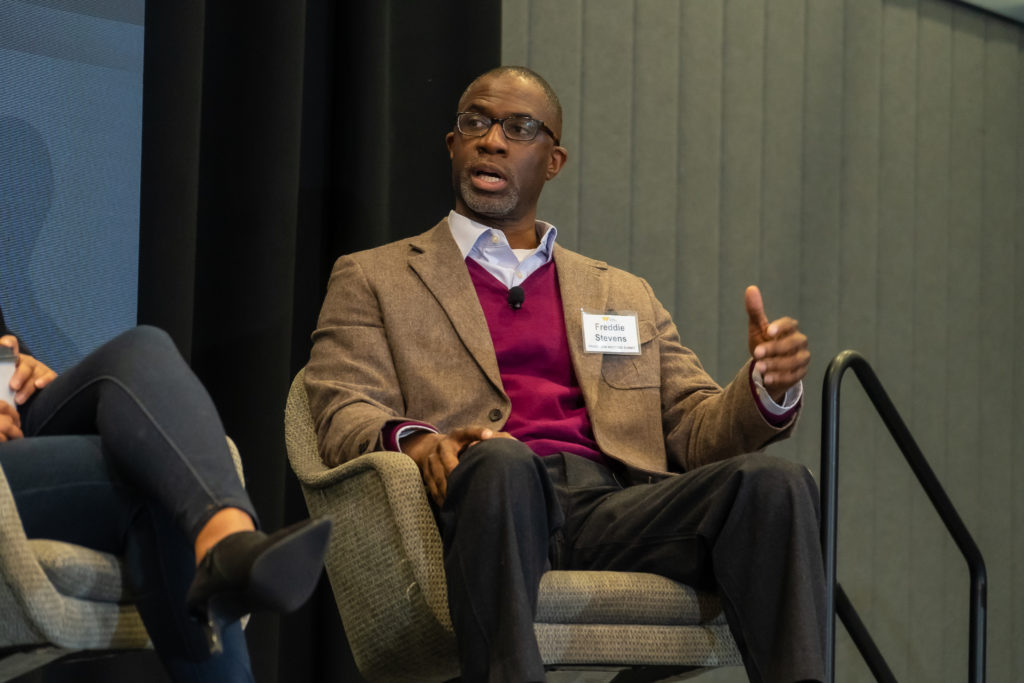
Freddie Stevens, Director of Housing, Grove Park Foundation
Stevens: “The BeltLine Partnership—some of our homeowner empowerment series [offers] workshops around tax exemption… making sure that families have the appropriate tax exemptions that they need to keep the property taxes down… We’ve worked collectively with the BeltLine Partnership team to make sure that we’re consulting and helping families to appeal their property taxes. Then certainly, the retention program, which has been key. I know with that Westside Future Fund has had their program for a while, and BeltLine Partnership’s program, particularly in our footprint, has been essential to make sure that those families have an opportunity to remain in the neighborhood.”
Stevens: “Homeowners are important… but those renters are being pushed out of the neighborhood. We made an effort initially to acquire property. One of the results of that is 9% lower from a housing tax credit project that we did with Columbia Residential. That project is massive with the lowest rents in the neighborhood, really across the city. Starting $695 one bedroom and $954 three bedroom. We were very aggressive and very intentional about making sure that we provide housing that serves the incomes for the people that are in the neighborhood. Our work will continue to be as such to make sure that folks who have 30%, 50%, 60% of area median income have an opportunity to remain in the neighborhood.”
Ahmann: “You mentioned some of the landholdings that y’all want to do for housing affordability, what can people expect to see planned over the next couple of years.”
Higgs: “What we’ve done over the last 12 to 18 months is essentially, we have tripled our land holdings along the BeltLine for housing affordability. We roughly control about 72 acres of land specifically for future affordability, all the way at the top in Buckhead all the way down to the south and western parts of the BeltLine.”
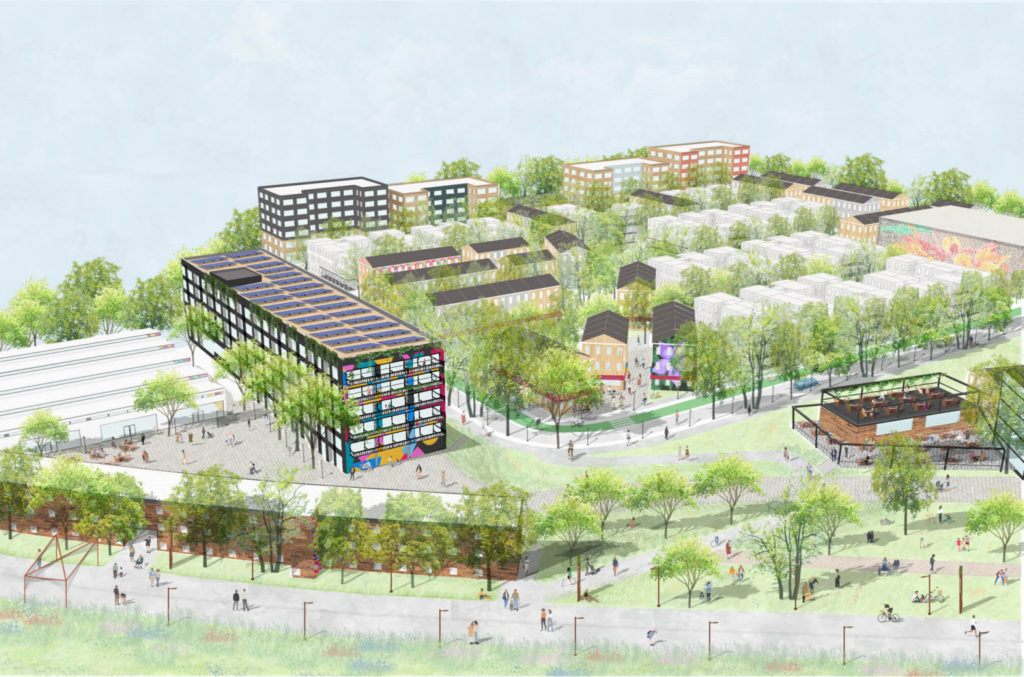
A rendering of the upcoming Murphy Crossings. To learn more, check it out here.
Higgs: “A property that we control in Oakland City, their park area called Murphy Crossing, it is roughly a 20-acre site. And we have selected the finalists out of Arizona along with a firm locally called Urban Oasis led by Joel Dickson to help us to reimagine what that site will look like. You will have affordability, housing affordability, you will have commercial affordability, green space, community space, a grocery store, and then from there we’re going to start looking at the Buckhead site. This is a smaller site, roughly about three acres, we probably can put maybe 100 to 120 units on that site. Probably the third quarter, fourth quarter of 2023, we’ll be able to start thinking about what we’ll do with that Chapel Road site. Again, that’s a huge undertaking—31 acres—but our goal is to make sure that we have significant community input. What does the community want on that site?”
Ahmann: “When key businesses are coming to town, I suspect you are in a room with them as they make location decision. Do they have affordability on their mind?”
Higgs: “We have a whole economic development team within the BeltLine, and they meet with businesses that are looking at Atlanta from a location perspective. And top of mind is if you’re going to come into this community you need to come correct. And that is making sure that you think about affordability and think about community first.”
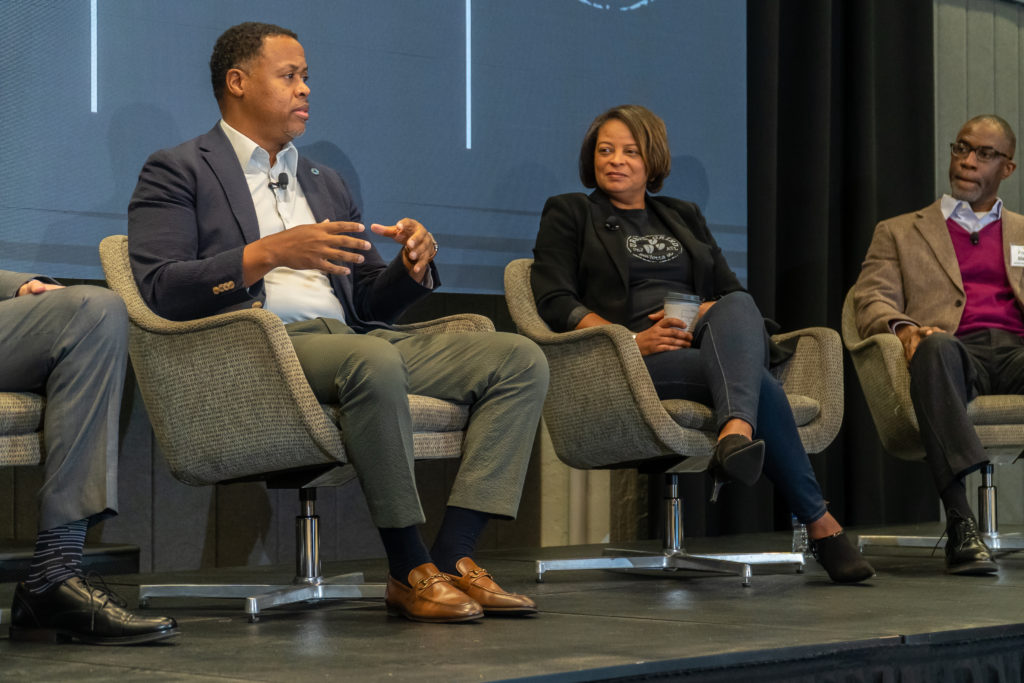
Clyde Higgs (left) talks conscientious location planning with corporations looking to move to Atlanta
Ingram: “I actually power the coffee shop at Microsoft in Atlantic Station. They were looking for small businesses to be a part of their vendor network, and it was important for them because it was important for us. So I power their coffee shop, provide them with their coffee, their recipes, training baristas, etc. That probably wouldn’t happen in most cities. So, thank you for the work you’re doing. I just wanted to say that it’s heard by them and they know to do business with us here when it’s important to us. They have to make sure that they communicate and they act accordingly.”
Brawner: “50,000 is the projection now of new full time jobs that are going to be created around the BeltLine. There’s some very intentional work going on the ABI, the partnership, other partners like Westside Works and others. We are working so the BeltLine residents can get the skills they need to work at these companies that are located along the BeltLine and have good jobs.”
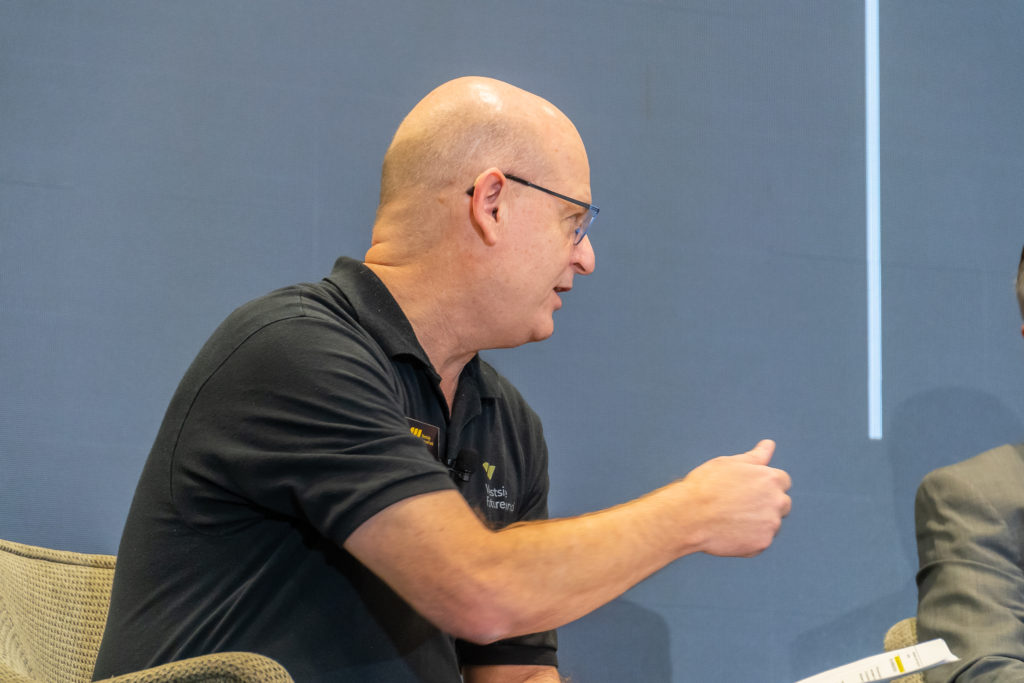
Moderator John Ahmann, WFF President & CEO
Ahmann: “In terms of the philanthropic community, the shift you saw in some of the things you’re raising funds around, affordability, you want to say anything more about that?”
Brawner: “The recognition by the philanthropic community of the importance of keeping existing residents in place, it is refreshing. I’m just being honest. But, think back 10-15 years ago—you’ve talked about affordability with all the many foundations—and the consensus was Atlanta has got plenty of affordable housing, right? I think there has definitely been a shift and a recognition that there is philanthropic support needed to help keep residents in place. I think one of the things I learned from this is even with the money, you have got to be in the neighborhood, in the community.”
View the full summit including the audience Q&A below!
